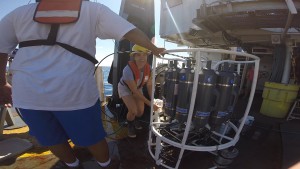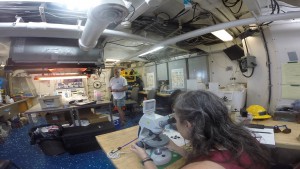by Jen Maucher Fuquay
During the past week I’ve been a part of the Ecosystem Assessment Survey cruise through the Florida Keys National Marine Sanctuary (FKNMS) aboard the NOAA ship Nancy Foster. Everyone has been working hard around the clock (literally!) collecting various sample types that will be analyzed as indicators of the health of this ecosystem.


As the coordinator for NOAA’s Phytoplankton Monitoring Program, I am usually working with our network of volunteer ‘citizen scientists’ to identify harmful algal bloom (HAB) species that can have potential health impacts on marine organisms like fish, turtles, and mammals (including us!). Here I have the opportunity to look for HAB organisms in this protected marine area as an added component to the research study. Another aspect I am introducing is the identification of marine plastics in the near surface waters, which will complement a similar study being done in the sediments. This will help us to establish for the first time a snapshot of how much plastic may be in FKNMS waters so that we can start to see what potential harm this may have on the organisms that live here.
Using a CTD and a ‘rosette’ of Niskin bottles, we collect water just below the surface. After taking water for the multitude of tests to look for nutrients, chlorophyll, and turbidity, the rest of the water is for me! I empty about 50 liters through my 20 µm phytoplankton net at each of the 30 stations. Part of that sample is kept for plastic identification, and the rest is used for phytoplankton identification. Although the in-depth analyses will take place once back on shore, I’ve been looking at some samples immediately (as long as the ship is not underway, that is- too shaky otherwise!). So far these very preliminary looks have only shown 2 potential HAB species present in very low numbers, but there have been several pieces of plastic fibers or fragments seen in 8 samples already. Hopefully the results from this will serve as a baseline upon which further study can be done on future assessment studies and we can begin to answer some questions about the effects of microplastic marine debris in this protected habitat.
